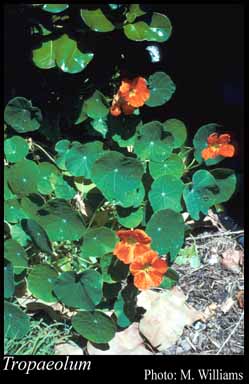- Reference
- Sp.Pl. [Linnaeus] 1:345 (1753)
- Name Status
- Current

Scientific Description
Family Tropaeolaceae.
Habit and leaf form. Herbs (or trailing), or herbaceous climbers; not resinous. Plants somewhat succulent. Annual, or perennial; plants with neither basal nor terminal concentrations of leaves; when perennial, tuberous. Prostrate or climbing; often petiole twiners. Leaves alternate, or alternate and opposite; petiolate (the petioles often long and twining); non-sheathing; gland-dotted, or not gland-dotted; simple; peltate. Leaf blades entire, or dissected; flat; when dissected, palmately lobed; palmately veined; cross-venulate. Leaves with stipules, or without stipules; without a persistent basal meristem. Stem anatomy. Nodes tri-lacunar. Secondary thickening absent, or developing from a conventional cambial ring.
Reproductive type, pollination. Fertile flowers hermaphrodite. Unisexual flowers absent. Plants hermaphrodite. Entomophilous. Pollination mechanism conspicuously specialized (in T. majus, the the anthers move sequentially to the nectariferous spur to shed their pollen before returning to their original positions, when the style moves to the spur. The hairs on the lower margins of the anterior petals exclude the entry of insects too small to effect pollination).
Inflorescence and flower features. Flowers solitary (axillary); medium-sized (showy); very irregular; zygomorphic. The floral asymmetry involving the perianth and involving the androecium. Flowers cyclic; pentacyclic. Free hypanthium present (the corolla slightly perigynous). Perianth with distinct calyx and corolla (but the calyx petaloid); 7–10; 2 -whorled; isomerous, or anisomerous (the corolla sometimes incomplete). Calyx 5 (the sepals petaloid); 1 -whorled; gamosepalous; 5 blunt-lobed; imbricate, or valvate; bilabiate; long spurred (from below the dorsal (adaxial) sepal(s)); with the median member posterior. Corolla 2–5 (the two upper members usually smaller and inserted in opening of spur, lower ones sometimes missing); 1 -whorled; polypetalous; imbricate; yellow, or orange, or red (to maroon), or white to cream. Petals clawed. Corolla members variously lobed or fringed, or entire. Androecium 8. Androecial members free of the perianth; markedly unequal (declinate); free of one another; 2 -whorled (four per whorl, the median of each supposedly suppressed). Androecium exclusively of fertile stamens. Stamens 8; filantherous (the filaments filiform). Anthers basifixed; dehiscing via longitudinal slits; latrorse; tetrasporangiate. Gynoecium 3 carpelled. The pistil 3 celled. Carpels reduced in number relative to the perianth to increased in number relative to the perianth. Gynoecium syncarpous; synstylovarious; superior. Ovary plurilocular; 3 locular. Gynoecium oblique; stylate. Styles 1; apical. Stigmas 3; 3 - lobed; dry type; non-papillate. Placentation axile to apical. Ovules 1 per locule; pendulous; epitropous; non-arillate; anatropous.
Fruit and seed features. Fruit non-fleshy; a schizocarp. Mericarps 3; comprising nutlets, or comprising drupelets. Dispersal unit the mericarp. Seeds 1 per mericarp. Seeds non-endospermic; with amyloid. Embryo well differentiated. Cotyledons 2 (thick). Embryo chlorophyllous (T. majus); straight. Seedling. Germination cryptocotylar.
Physiology, biochemistry. Mustard-oils present. Photosynthetic pathway: C3.
Geography, cytology, number of species. Adventive. Australian states and territories: Western Australia. South-West Botanical Province.